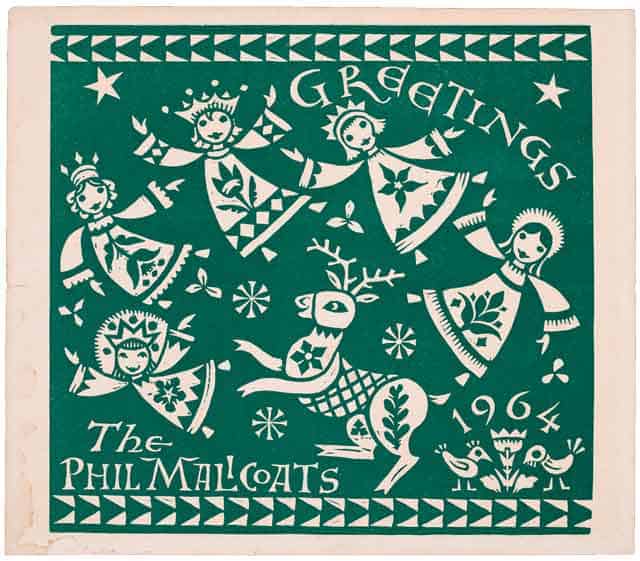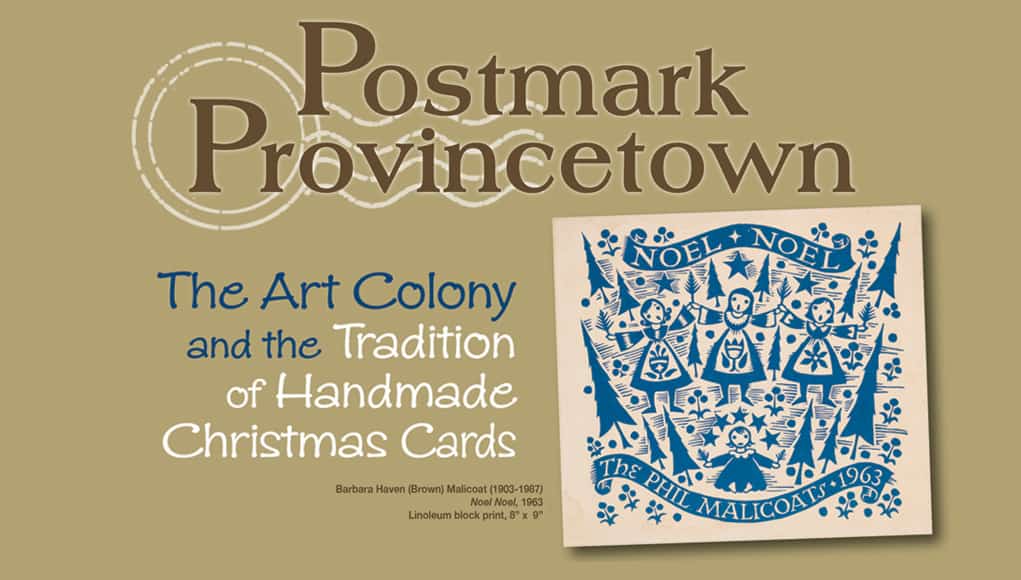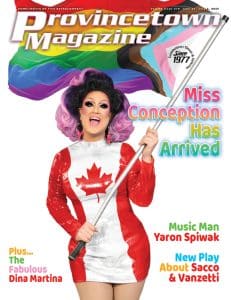The Art Colony and the Tradition of Handmade Christmas Cards
by Steve Desroches
The practice of sending greeting cards for a variety of occasions is an ancient custom with ties back to antiquity in China and Egypt. And come the 15th century, cards for the New Year and Valentine’s Day were commonly exchanged in Europe. In Victorian England Christmas cards became incredibly popular, and by the 20th century postcard and greeting card companies in the United States began to mass-produce and market their products for just about every event that can be imagined. They’ve been such a part of so many cultural expressions for so long. Perhaps they’re taken for granted a bit as just an ephemeral sentiment. But on closer inspection, in addition to the message from a friend or family, each card is a bit of art in your mailbox, usually designed by an unknown hand ever since the Industrial Revolution brought about mass manufacturing. But for many artists and artisans the practice of making a card by hand seemed only natural, a custom and tradition that lasted for decades here once the art colony was founded in 1899, and in the process put a uniquely Provincetown mark on their creations.

Linoleum block print, 8” x 9”
At the outbreak of World War I in 1914, the Provincetown art colony received an infusion of new views and ideas when Americans living in Europe, as well as European artists, fled the continent, many settling in New York’s Greenwich Village as well as here in the summers, or year-round. In the years that followed, a group of artists that came to be known as the Provincetown Printers developed the white-line woodcut print, sometimes called the “Provincetown print.” Instead of creating separate wood blocks for each color, only one was used, and in most cases the space in between the shapes creating the image was left white, though not always. This practice became popular very quickly, garnering international attention from the art world as to what was happening in Provincetown. While the prints graced the walls of galleries around Provincetown, the artists who worked in the medium also began to use the technique when making Christmas cards each holiday season, creating small works of art that are now collectible themselves. The Provincetown Art Association and Museum (PAAM) has about a dozen of these cards in their collection, according to Chief Executive Officer Christine McCarthy, dating from 1928 to 1965.

“Based on the artists who created the cards (this is referencing the PAAM collection), it seems as if the holiday cards would have transpired out of the white-line tradition considering that many of the artists represented were printmakers: Oliver Chaffee, Blanche Lazzell, Ferol Warthen, Charles Martin, and Barbara Haven Brown Malicoat,” says McCarthy. “It would make sense to use printmaking as the vehicle for making multiples, which most people do when sending holiday cards instead of creating a unique one for each person or family. And why would you spend money on buying holiday cards if you could make them? I know that artists used to make invitations to parties or gatherings through printmaking, as well. I think it served as an economic and creative vehicle for well-wishing and gathering.”
In 2009 PAAM presented a show curated by artist Breon Dunigan featuring over 70 of these holiday cards, some of which were made by Dunigan’s grandmother Barbara Malicoat, who would add an image of each new grandchild as they were born that year. The show increased the attention and interest in these cards, which are considered rare, as many were not saved over the years. In addition, the custom faded, as the artists that began it were largely all gone come the 1970s. In 2011, to help revive the tradition PAAM held a juried show, overseen by artists Pasquale Natale and David Foley, that featured original holiday cards chosen for exhibition.

Linoleum block print, 9” x 8”
Many of the cards in PAAM’s collection. as well as those held by private collectors, are specific in their imagery of Provincetown, Cape Cod, and maritime life, making them even more valuable, historically and artistically. One card in particular, not in PAAM’s collection, was created in 1918 by Mildred “Dolly” McMillen and features her with fellow artist Ada Gilmore relaxing on a winter’s night by a cast iron wood stove. It’s long attracted attention not just for its artistic aspects, but also its bold depiction of two women together in such a domestic situation. Is it an early expression of two relatively out lesbians? Is it a document of a so-called “Boston Marriage,” where women seeking independence lived together sometimes in romantic relationships, sometimes not? Or perhaps it’s evidence of the bohemian ways of many in Provincetown at a time when social conventions were eschewed for then-radical thoughts on open marriages and the like, as they sent out Christmas greetings as a couple, and their cat Pico, with an extra layer of wondering if it is named for one of the islands in the Azores, another uniquely Provincetown feature considering the town’s Portuguese heritage. It’s not appropriate to place labels on anyone, especially when looking back historically, but the image nevertheless stands out as particularly Provincetown.
“Both Gilmore and McMillen were part of the Provincetown Printers,” says McCarthy. “They met in Chicago studying at the Art Institute, then went to Paris to study with Ethel Mars who also came to Provincetown. They moved to Provincetown together in 1914. McMillen preferred to print in black and white and I believe this is her design in the card. Gilmore was married to Oliver Chaffee, although she and McMillen were longtime companions.”




